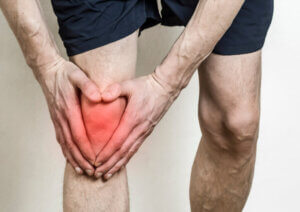How to Treat a Meniscus Tear

The meniscus is a part of the knee that’s easily torn. Knowing how to treat a meniscus tear is of great importance for any athlete, especially when practicing high-impact activities. But is it serious? How long does recovery take?
What is the meniscus?
The menisci are cartilaginous structures that absorb the impact between the femur and the tibia. Whenever you take a step, your leg supports all your weight: that’s when menisci play their role.
In each knee, there are two menisci: one internal and one external, and they both absorb and distribute pressure in order to protect the bones. They also help stabilize the knee joint, which they’re a part of.
The problem is that, despite being elastic and resistant, the constant force they’re put under in each bipedal movement, takes its toll. That’s when the typical meniscus tear occurs.
What is a meniscus tear?
A meniscus tear happens when some of the fibers in the cartilaginous tissue break, thus interrupting the structure’s continuity.

The potential causes for it are:
- Sudden movement: when trying to absorb an impact, if the movement is too abrupt, the meniscus may not hold it and tear.
- Wear: the menisci work constantly and throughout a person’s lifetime. Every step you take is possible due to them. Being cartilaginous tissue, they have a lower blood supply, so they can’t regenerate as muscles do. In fact, only one-third of their peripheral side receives blood flow.
- Trauma: during contact sports, there’s a chance that a strong impact on the knee causes a meniscal tear.
How to treat a meniscus tear
In the event that your knee hurts and medical tests determine that there’s a meniscus tear, what should you do? Well, there are two options: the surgical one and the non-surgical option.
Several factors will condition whichever option you choose. For example, the severity of the tear and your level of activity, meaning if it’s a small tear and you only play sports occasionally, you probably won’t need surgery.
However, if you’re a professional athlete and the tear is more severe, you’ll have to undergo surgery, even if you’re not an elite athlete; if the pain is strong and it prevents you from doing everyday activities, surgery is the way to go.
Non-surgical treatment
Treatment for a meniscus tear in a non-surgical way is very similar to treatment during an inflammatory process:
- Apply ice for the first few days after the tear
- Keep the area compressed to promote the reabsorption of any extravasated liquid, which cures the hematoma and prevents it from spreading.
- Rest and avoid any high-impact activity.
- Keep the affected leg raised (above the heart level), so that gravity helps with venous return. This will contain the inflammation and control the hematoma.
Finally, it’s important to see a physiotherapist that creates a personalized rehabilitation guide with exercises that adapt to each recovery phase, especially stretching and proprioceptive exercises.
Surgical treatment
Surgery consists of an arthroscopy, as explained in a University Hospital of Caracas’ publication. The surgeon makes two small incisions in the knee that won’t leave a mark and that will make post-operative care easier.
Using this technique, the surgeon will file or trim the damaged area of the meniscus (depending on the extent of the injury). After the operation, the knee is immobilized for a few days until the incision heals. Then, rehabilitation through physiotherapeutic treatment begins immediately.
An injury with a full recovery
The good thing about meniscus tears is that patients usually regain their pre-injury abilities after rehabilitation. There are very serious cases in which knee replacement is the best option, but they’re very rare.
Therefore, treating a meniscus tear is feasible in the vast majority of cases. If you suffer an injury of this kind, don’t despair: follow your doctor’s instructions and try to avoid any movements that could worsen the tear.
The meniscus is a part of the knee that’s easily torn. Knowing how to treat a meniscus tear is of great importance for any athlete, especially when practicing high-impact activities. But is it serious? How long does recovery take?
What is the meniscus?
The menisci are cartilaginous structures that absorb the impact between the femur and the tibia. Whenever you take a step, your leg supports all your weight: that’s when menisci play their role.
In each knee, there are two menisci: one internal and one external, and they both absorb and distribute pressure in order to protect the bones. They also help stabilize the knee joint, which they’re a part of.
The problem is that, despite being elastic and resistant, the constant force they’re put under in each bipedal movement, takes its toll. That’s when the typical meniscus tear occurs.
What is a meniscus tear?
A meniscus tear happens when some of the fibers in the cartilaginous tissue break, thus interrupting the structure’s continuity.

The potential causes for it are:
- Sudden movement: when trying to absorb an impact, if the movement is too abrupt, the meniscus may not hold it and tear.
- Wear: the menisci work constantly and throughout a person’s lifetime. Every step you take is possible due to them. Being cartilaginous tissue, they have a lower blood supply, so they can’t regenerate as muscles do. In fact, only one-third of their peripheral side receives blood flow.
- Trauma: during contact sports, there’s a chance that a strong impact on the knee causes a meniscal tear.
How to treat a meniscus tear
In the event that your knee hurts and medical tests determine that there’s a meniscus tear, what should you do? Well, there are two options: the surgical one and the non-surgical option.
Several factors will condition whichever option you choose. For example, the severity of the tear and your level of activity, meaning if it’s a small tear and you only play sports occasionally, you probably won’t need surgery.
However, if you’re a professional athlete and the tear is more severe, you’ll have to undergo surgery, even if you’re not an elite athlete; if the pain is strong and it prevents you from doing everyday activities, surgery is the way to go.
Non-surgical treatment
Treatment for a meniscus tear in a non-surgical way is very similar to treatment during an inflammatory process:
- Apply ice for the first few days after the tear
- Keep the area compressed to promote the reabsorption of any extravasated liquid, which cures the hematoma and prevents it from spreading.
- Rest and avoid any high-impact activity.
- Keep the affected leg raised (above the heart level), so that gravity helps with venous return. This will contain the inflammation and control the hematoma.
Finally, it’s important to see a physiotherapist that creates a personalized rehabilitation guide with exercises that adapt to each recovery phase, especially stretching and proprioceptive exercises.
Surgical treatment
Surgery consists of an arthroscopy, as explained in a University Hospital of Caracas’ publication. The surgeon makes two small incisions in the knee that won’t leave a mark and that will make post-operative care easier.
Using this technique, the surgeon will file or trim the damaged area of the meniscus (depending on the extent of the injury). After the operation, the knee is immobilized for a few days until the incision heals. Then, rehabilitation through physiotherapeutic treatment begins immediately.
An injury with a full recovery
The good thing about meniscus tears is that patients usually regain their pre-injury abilities after rehabilitation. There are very serious cases in which knee replacement is the best option, but they’re very rare.
Therefore, treating a meniscus tear is feasible in the vast majority of cases. If you suffer an injury of this kind, don’t despair: follow your doctor’s instructions and try to avoid any movements that could worsen the tear.
All cited sources were thoroughly reviewed by our team to ensure their quality, reliability, currency, and validity. The bibliography of this article was considered reliable and of academic or scientific accuracy.
- V. Pereira, I. Escalante, I. Reyes et al. Estudio de los tipos de lesiones de meniscos más frecuentes en la Unidad de Cirugía Artroscópica del Hospital Universitario de Caracas. Vitae: Academia Biomédica Digital, Nº. 27, 2006
- M. Barrera, J. Recondo, C. Gervás et al. Rotura de menisco. Errores diagnósticos en RM. Radiología. Volume 45, Issue 1, Pages 32-36, 2003
- D. Múscolo, G. Pineda, A. Makino et al. Artroscopía y resonancia magnética en lesiones traumáticas de rodilla. Rev. Asoc. Argent. Ortop. Traumatol ; 58(2): 237-46, 1993
This text is provided for informational purposes only and does not replace consultation with a professional. If in doubt, consult your specialist.








